A False Sense of Data Security
UPDATE 11/26/2020: After the latest update to tenant settings, I’m glad that the new “Export to …” settings don’t affect external connections anymore. There is now a new setting “Allow live connections” to control external connectivity. Read “Updated Export Settings” to learn more.
The Power BI “Export data” setting is horrible. I wish Microsoft never came up with it and no other Microsoft tool has it. Apparently, the premise here is to prevent users from exporting data behind the report so it does not end up in wrong hands. But all it accomplishes is a false sense of data security and does more damage than good. Like users can’t take screenshots and share them wherever they please. Or print and mail reports. Unless of course, you disable printing reports too, but where is that path of not trusting your users going? Why don’t you just disallow them from viewing reports at all? “No data, no problem”, right?
Besides “exporting” data, this setting effectively disables all external connections to published datasets. Therefore, the following Power BI features won’t work:
- Creating reports from published datasets, which is a best practice.
- Publishing semantic models from Visual Studio via the Power BI Premium XMLA endpoint. Even if you enable the XMLA endpoint for read/write, “Export data” will overwrite it because it’s highest level overwrite
- Connecting other tools to published datasets, such as SSMS, Tabular Editor, DAX Studio, Profiler, and third-party reporting tools.
- Using the “Analyze in Excel” feature for creating Excel reports connected to published datasets.
So, leave “Export data” enabled. If you really want to prevent sensitive data outside your organization, consider applying sensitivity labels which integrate with Office 365 information protection.




 More and more organizations are switching to Microsoft Teams mostly for online meetings. However, Microsoft Teams can deliver much more than that and it will be unjust to compare it with other popular meetings apps. In this newsletter you’ll learn how Prologika helped a public school district gain important insights from Microsoft Teams. Learn more and try an interactive Power BI report in the
More and more organizations are switching to Microsoft Teams mostly for online meetings. However, Microsoft Teams can deliver much more than that and it will be unjust to compare it with other popular meetings apps. In this newsletter you’ll learn how Prologika helped a public school district gain important insights from Microsoft Teams. Learn more and try an interactive Power BI report in the 




